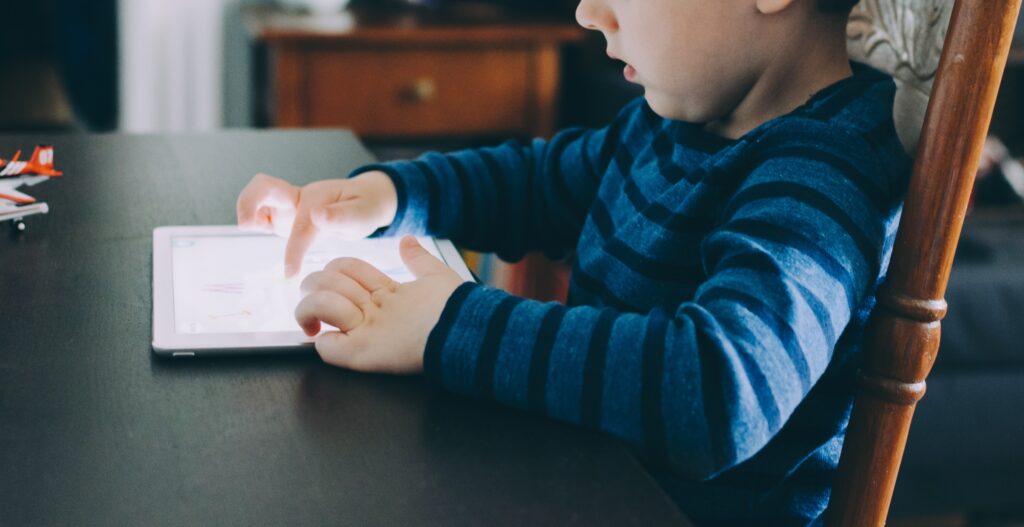Using her experience as a public health consultant and a mother of three kids aged 10, 8 and 3, Rebecca Zosel offers parents some tried and tested screen time strategies and explores how her family makes screen time work for them.
We all want our children to be healthy, but sometimes it’s hard to know what is best for them. And let’s face it – even when we know what we should be doing, it can be hard to act accordingly and live our best lives.
Screen time for children is an area that’s particularly challenging. Alongside the common wisdom that too much screen time is detrimental to their health and development, is the reality that technology is integral to our daily lives and will be an important part of our children’s future.
In my family, screen time is part of a balanced and healthy lifestyle.
We have clear rules about screen time that include where, when and how the children can use screens.
In our home, devices are kept in the family room. We keep screens out of bedrooms, particularly at night, and they aren’t used in the car. Electronic devices including the TV are not used at all Monday through Friday, as the focus on weekdays is squarely on school. We are more flexible on weekends, when the children are free to watch TV in the morning, and possibly a movie later in the day. My primary school aged children also have one short screen time session (half-hour) on the iPad to play games – but only after lunch, and chores must be done first. My husband and I help our children to choose good-quality apps and games and review each app before it is downloaded. We encourage screen use that is fun and involves learning.
We make sure that screen time is balanced with other activities. Because our children’s screen time is contained, they have lots of time to play. They participate in a maximum of two extra-curricular activities – mostly sports, which leaves them with plenty of unstructured time at home. My kids love having play-dates with friends, reading, riding their bikes and building cubbies. They are sometimes bored, but that is OK.
Image credit: Max Goncharov on Unsplash
Some strategies that we use to manage screen time with our primary school aged children are:
- Be a positive role model – We ensure that our own device use is consistent with the expectations we have of our children.
- Be consistent – Consistency is key to embedding healthy habits in young kids lives. It also helps to avoid constant debates and challenges about screen use.
- Be Supportive – Support children to take responsibility for monitoring their own screen time. For example, our children use a 30 minute glass sand timer to monitor their time on the iPad. Having the sand timer as a visual aid helps them to understand how much time they have left, and to make decisions about how they use their time. This self-monitoring mostly works, although I also take a mental note of the time their session starts and intervene after half-an-hour if they go overtime.
- Be proactive – It is important to discuss your kids’ screen time rules and expectations with the other adults in their lives that are at times responsible for them i.e. grandparents and babysitters. This will help to avoid sending them mixed messages about screen use.
Most of all, it is important to remember that what works for one family won’t necessarily work for another, every family is different!
To help you with finding what works for your family, here are some expert recommendations and resources:
Expert recommendations
- Australian Department of Health guidelines recommend that children under 2 years of age have no screen time, a limit of one hour per day for 2–5‐year‐old children, and a limit of 2 hours of recreational screen time per day for 5–17‐year‐old children.
- In 2019 the World Health Organization (WHO) released new guidelines on physical activity, sedentary behaviour and sleep for children under 5 years of age that emphasis that children need to sit less and play more to grow up healthy. More specifically, the guidelines state that infants under 1 year old should not be exposed to electronic screens and that children between the ages of 2 and 4 should not have more than one hour of sedentary screen time each day.
Expert resources
- Parents’ Voice provide some useful tips on how to reduce screen time in your household.
- The e-SafetyCommissioner offers great online safety advice for parents and carers to help children have safe, enjoyable experiences online.
- Raising Children discuss what constitutes healthy screen use for school aged children.
- This New York Times article explores new research which challenges assumptions about the negative effects of social media and smartphones on children.
You can connect with the author of this blog, Rebecca Zosel, via Twitter and LinkedIn.
Feature image credit: Kelly Sikkema on Unsplash





